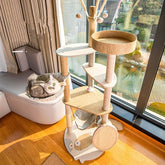Understanding Your Cat's Vocalizations: Why Is My Cat So Loud?
Table of Contents
- Key Highlights:
- Introduction
- The Spectrum of Cat Vocalizations
- Understanding the Causes of Loud Vocalization
- Common Misconceptions About Cat Vocalizations
- Practical Strategies for Managing Loud Vocalizations
- Expert Insights: Veterinary Perspectives on Cat Vocalizations
- Smart Pet Parent Tip 🐾
- FAQ
Key Highlights:
- Cats vocalize for various reasons, including attention-seeking, hunger, stress, and health issues.
- Different types of vocalizations serve distinct purposes, from meows to yowls and chirps.
- Recognizing the underlying causes of your cat's loud behavior can enhance your relationship and improve their well-being.
Introduction
The cat's meow is more than just a sound; it is a complex form of communication that reflects a cat's emotional state, needs, and instinctual behaviors. For cat owners, sudden outbursts of meowing or yowling can be both surprising and concerning. Understanding the reasons behind these vocalizations is essential for nurturing a healthy and harmonious relationship with your feline companion. This exploration delves into the various aspects of why cats are often vocal, the different sounds they produce, and how these behaviors can be interpreted.
The Spectrum of Cat Vocalizations
Cats possess a diverse range of vocalizations, each serving different communicative purposes. Understanding this spectrum not only helps owners decode their pets’ needs but also fosters a deeper bond between them.
Meowing: The Most Common Call
Meowing is perhaps the most familiar sound associated with cats. Unlike dogs, who mainly bark to communicate with humans and other animals, cats reserve their meows primarily for human interaction.
- Attention-Seeking: A cat may meow loudly to draw attention, signaling that they want to play, be petted, or simply want company. This behavior is especially common in younger cats who thrive on social interaction.
- Hunger: Many cats meow as a way to indicate that they are hungry. A persistent meow might be their way of telling you it's mealtime.
- Affection: Some cats meow softly when they are near their owners, a sign of affection and comfort.
The Yowl: A Call for Help or Distress
Yowling is a louder, elongated version of meowing, often associated with more intense emotions or situations.
- Mating Calls: Unspayed female cats yowl to attract mates, a behavior that can be quite loud and persistent during mating season.
- Territorial Claims: Cats may yowl to assert dominance over their territory, especially if they sense another cat encroaching on their space.
- Distress Signals: If a cat is in distress due to injury, illness, or fear, they may yowl loudly to seek help or express discomfort.
Chirping and Other Sounds: A Hunter's Language
Chirping is a unique vocalization that some cats exhibit, often resembling bird calls.
- Hunting Instincts: This sound may occur when a cat is observing birds or small prey, expressing excitement or frustration at not being able to catch them.
- Communication: Chirping can also serve as a way for cats to communicate with their owners during play, mimicking the sounds of their prey.
Understanding the Causes of Loud Vocalization
Several factors contribute to why a cat might be excessively vocal. Identifying the root cause is critical for addressing the behavior effectively.
Attention-Seeking Behavior
Cats are intelligent and social animals that thrive on interaction. A loud meow can indicate that your cat is feeling ignored or bored, prompting them to seek your attention. Engaging in regular playtime, providing stimulating toys, and ensuring quality time with your cat can help reduce this behavior.
Hunger and Feeding Patterns
A cat’s vocalizations often correlate with their feeding schedule. If your cat consistently meows loudly at specific times, it might be related to hunger. Providing consistent feeding times and ensuring access to fresh water can mitigate excessive meowing due to hunger.
Stress and Anxiety
Cats are sensitive creatures, and changes in their environment can lead to increased vocalization. Factors such as moving to a new home, introducing new pets, or even changes in routine can trigger stress-induced meowing. Creating a safe and stable environment with cozy spaces can help alleviate anxiety.
Health-Related Issues
Excessive vocalization might also signal underlying health concerns. Conditions such as hyperthyroidism, dental issues, or cognitive dysfunction can lead to changes in vocal patterns. If your cat’s loud vocalizations accompany other symptoms like lethargy or changes in appetite, a veterinary consultation is essential.
Common Misconceptions About Cat Vocalizations
Many pet owners hold misconceptions about why their cats are vocal. Understanding the nuances of feline communication is vital for effective pet care.
All Cats Are Quiet
A common misconception is that all cats are inherently quiet. While some breeds or individual cats may be less vocal, many cats are naturally talkative. Recognizing that vocalization can be a normal part of their behavior is crucial for understanding your cat’s needs.
Meowing Equals Discontent
Another misunderstanding is that a cat’s meowing always indicates distress. Cats can meow for various reasons, including happiness, contentment, or playfulness. Observing the context of the meowing can provide clarity regarding your cat’s emotional state.
Practical Strategies for Managing Loud Vocalizations
To ensure a peaceful coexistence with your vocal feline, consider practical strategies that address their vocal needs without reinforcing unwanted behaviors.
Provide Mental Stimulation
Interactive toys, puzzle feeders, and engaging playtime can help keep your cat mentally stimulated, reducing the chances of excessive meowing due to boredom.
Establish a Routine
Cats thrive on routine, so establishing consistent feeding and play schedules can help manage their expectations and reduce attention-seeking vocalizations.
Create a Safe Space
Designate a quiet area for your cat to retreat to when feeling stressed. Incorporating calming elements, such as soft bedding and hiding spots, can help your cat feel secure and minimize anxiety-related vocalizations.
Regular Veterinary Check-Ups
Routine veterinary visits are essential for monitoring your cat's health. Early detection of medical issues can prevent unnecessary changes in vocalization patterns.
Expert Insights: Veterinary Perspectives on Cat Vocalizations
Veterinary professionals highlight the importance of understanding the context behind feline vocalizations. According to feline behavior specialists, cats use vocalizations to communicate their needs effectively. By tuning in to these vocal signals, pet owners can foster a better understanding of their cats' emotional states.
Addressing Common Concerns
Veterinarians often encounter questions from cat owners regarding specific vocalization behaviors. Here are some common inquiries along with expert advice:
Q: Why does my cat meow loudly at night?
Cats may meow at night due to boredom or a desire for attention. To mitigate this, consider engaging in playtime before bed and providing interactive toys that can keep them occupied.
Q: Is it normal for my cat to yowl during mating season?
Yes, yowling is typical in unspayed female cats during mating season. Spaying or neutering can help prevent these vocalizations and contribute to overall health and well-being.
Q: How can I tell if my cat’s loud vocalizations indicate a medical issue?
If loud vocalizations are accompanied by lethargy, changes in appetite, or difficulty breathing, a veterinary visit is warranted to rule out health problems.
Q: My older cat has started meowing loudly more frequently. Should I be concerned?
Increased vocalization in older cats can signal age-related health issues. Scheduling a veterinary appointment can help evaluate your cat’s overall health.
Q: How can I help my cat feel more comfortable during stressful situations?
Creating a calm environment, using calming pheromones, and providing interactive toys can help alleviate stress and anxiety in your cat.
Q: My cat chirps and chatters at birds outside the window. Is this behavior normal?
Yes, this is a common behavior among cats that reflects their natural hunting instincts. Allowing your cat to watch birds from a safe distance can provide mental stimulation.
Smart Pet Parent Tip 🐾
Pay close attention to your cat’s vocalizations and behaviors. Understanding their unique sounds and what they signify can greatly enhance your relationship and ensure your cat receives the care and attention they need to thrive.
FAQ
Why is my cat vocalizing more than usual?
Increased vocalization can result from various factors, including changes in environment, attention-seeking behavior, stress, or health issues. Monitoring your cat’s overall behavior can help pinpoint the cause.
Can loud vocalizations indicate a health problem?
Yes, excessive vocalizations can be a sign of medical issues. If your cat’s vocalizations change significantly or are accompanied by other symptoms, a veterinary evaluation is recommended.
Do certain cat breeds vocalize more than others?
Yes, some breeds, such as Siamese and Burmese, are known for their vocal tendencies. Understanding your cat’s breed can give insight into their communication style.
How can I train my cat to be less vocal?
Training a cat to reduce vocalizations involves reinforcing quiet behavior through positive reinforcement, providing mental stimulation, and addressing any underlying needs for attention or comfort.
Should I be worried if my cat suddenly becomes quiet?
A sudden change in vocalization patterns, whether becoming excessively quiet or loud, can be a cause for concern. It may indicate health issues or emotional distress, warranting a visit to the veterinarian.
Understanding your cat’s vocalizations is an essential part of responsible pet ownership. By recognizing the reasons behind their sounds, you can create a nurturing environment that meets their needs, ultimately leading to a happier and healthier feline companion.





